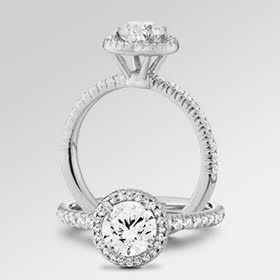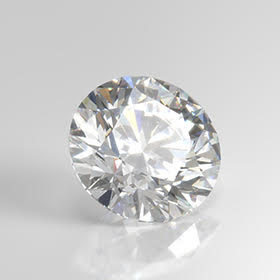At this point in time, our guess is that most people have never heard of lab-grown diamonds and that’s okay! It’s a new thing, we understand. Being in the 21st century, the first thing I’d do is Google it.
What are lab grown diamonds?
Are lab-grown diamonds worth anything?
Are lab grown diamonds real?
Are lab created diamonds any good?
It’s great that people are curious, we’re curious people too! At New World Diamonds we are here to help you through the journey of understanding lab-created diamonds.
So let’s jump in and answer some of these basic questions.
These lab-grown diamonds are real diamonds, pure crystallized carbon. Lab-created diamonds using the CVD method will pass tests used to confirm a pure carbon diamond and go through the same certification process as mined diamonds. The difference is that they are grown in highly controlled laboratory environments that duplicate the conditions under which diamonds naturally develop beneath the Earth's crust.
Now let’s get into the nitty-gritty.
Have you ever heard of a “blood diamond”? It’s okay if you haven’t. It’s a term you will probably come across when researching and purchasing a diamond.
Blood diamonds are gems mined in war zones and then sold in order to fund violent conflicts and wars in those nations. The conflict-laden diamonds are distributed around the world, and often times into the American market. Because the origins of these diamonds are extremely difficult to trace, a system called The Kimberley Process was created in 2000 to prevent conflict diamonds from entering mainstream markets.
Despite the stringent regulations in place surrounding the origins and sale of diamonds, gaps in the global supply chain, unfortunately, still exist today.
Informal mining is also a concern when talking about mined diamonds because there aren’t strict regulations in place for how miners are compensated or how unsafe work conditions are avoided. This happens mostly in places that practice alluvial mining. We’ll talk more about that later.
Miners often work for less than $1 a day and we’re not talking adults only. Given the lack of child labor laws in countries across the world, kids as young as five years old are put to work in alluvial mining. The conditions are horrible and often times the work environment is dangerous.
By choosing lab-grown diamonds, you’re ensuring that no child was involved in sourcing your diamond nor was anyone underpaid to do dangerous work.
So now that our fellow humans are taken care of, what about the planet? What about those cute animals, plants and ecosystems that can be affected by human industry?
Diamond mining actually takes a huge and definitely not cute toll on the surrounding environment. Traditionally it involves digging a huge pit in the earth in order to reach a store, or pipe, of diamonds. Side effects of this include cutting down massive portions of forests, disrupting ecosystems and displacing communities of people that live there.
Remember alluvial mining from a little earlier? It involves uncovering diamonds that have surfaced in riverbeds due to erosion, which in turn means humans have to drain or reroute rivers, drastically changing the environment for miles. Most mining of this kind takes place in Africa, specifically along the Atlantic coast and Namibia. A whopping 24% of diamonds are mined in this way, 10% from industrial alluvial mining and 14% from informal or artisanal, alluvial mining.
Another example of environmental destruction currently up for debate today is whether or not one of the largest diamond mining companies in the world will do a whole lot of mining in the Chhatarpur forests of central India. They want to cut down approximately 2500 acres of forest, which doesn’t sound great in the first place, but the expanse is also home to a Bengal Tiger corridor (a tract of land through which tigers migrate), not to mention local communities and countless species of flora and fauna.
Whether they will decide to dig in the Chhatarpur forest is still up for debate. What is NOT up for debate is the fact that growing diamonds above ground does not demolish any natural habitats for animals or humans. Think of it this way: mining involves destruction, growing involves creation.
Another potential issue with getting diamonds from below ground is that their origin is highly suspect. There could be no way of knowing if your diamond was the result of devastating deforestation or displacement of life.
Most diamond origins are actually untraceable and most natural diamonds out there, like the ones in your grandmother’s jewelry box, were removed from the earth prior to 2000, before the Kimberley Process was put into effect.
Meaning, very simply, we don’t know where most diamonds came from, period.
We know they came from the earth at some point, but what’s not clear is whether they came from a company with ethical practices or if they were originally mined as a way to fund violent wars.
Lab grown diamonds are some of the only diamonds with known traceable origins.
Here at New World Diamonds, you can be extra sure because not only do we sell them, we’re the ones making them. From start to finish, we’ve got our eyes on the entire supply chain and everyone involved.
Because lab-created diamonds pass through fewer hands on their way to you, they just don’t cost as much to produce. The topic of the cost is especially relevant if colored diamonds are thrown into the mix. Unlike earth formed white diamonds, colored diamonds formed in the earth are exceedingly rare and priced to match. However, growing a colored diamond in a lab is something we have gotten pretty good at over the years. We are super excited to offer a rainbow of colored diamonds at affordable prices.
One of the first and most important things people find about lab-grown diamonds when they start to research is just how friendly lab-grown diamonds can be for your wallet. If you compare the prices of natural diamonds from well-known retailers, such as Helzberg or JC Penny, to the prices of lab-grown diamonds, there can be as much as a 50% reduction in price for the same sized stone. In short: lower production cost = lower purchase price = you can afford a bigger diamond.
At the end of the day, we want to help you base your diamond decision on the factors that are important to you. If you’re the kind of person that knows you want to purchase a diamond that’s kind to the environment, other people and your wallet, then we hope you’ll immediately recognize our lab-created diamonds are the perfect option.
We’ve covered a lot of ground today, if you want to talk with one of us in more detail about our lab created diamonds please call at 877-653-2250. Really, we love talking diamonds!










